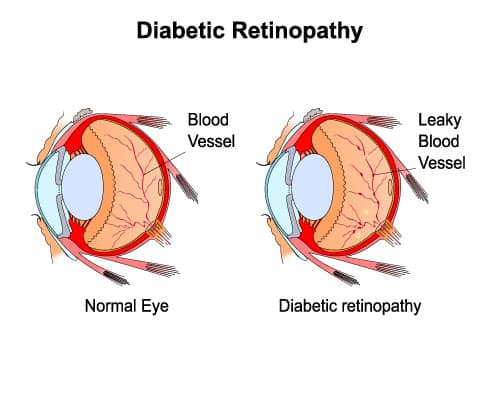Diabetic Retinopathy
Patients with diabetes are at a higher risk of developing many eye conditions, including diabetic retinopathy. Even if your diabetes is controlled, it is essential to learn about this condition, as it can result in partial or total vision loss.
At Wooster Eye Center, we offer extensive diabetic retinopathy screening and state-of-the-art treatments to help you protect your vision and get the care you need.
What is Diabetic Retinopathy?
Diabetic retinopathy is a diabetic eye condition that occurs when high blood sugar levels cause blood vessels in the retina to leak, swell, weaken, or close off. It can also cause abnormal blood vessels to develop on the surface of the retina.
These changes in the eye can cause vision problems and eventually lead to blindness if left untreated. It can also contribute to other eye conditions, such as glaucoma, cataracts, and macular edema.
Diabetic retinopathy appears in two types:
NPDR (Nonproliferative Diabetic Retinopathy)
Nonproliferative diabetic retinopathy is when blood vessels in the eye leak into the retina in the early stages of the condition, causing it to swell and form deposits called exudates. Hemmorage, fluid, or lipid is visible in the retina.
Blood vessels may also close off in a process called macular ischemia, preventing blood from reaching the macula. You may experience blurry vision and other mild vision changes, but many people do not experience symptoms at this stage, making it harder to diagnose.
PDR (Proliferative Diabetic Retinopathy)
Proliferative diabetic retinopathy is the later stage of the condition when the retina starts to grow abnormal blood vessels. It does this to compensate for the closure of blood vessels with nonproliferative diabetic retinopathy and restore blood flow.
These abnormal blood vessels can start to leak blood into the vitreous of your eye, the clear gel that allows light to pass through to the retina and maintains eye structure. Minimal bleeding may only cause floaters, but excessive bleeding can block all vision.
Another problem that may occur when your retina grows abnormal blood vessels is the development of scar tissue. This can lead to problems with the macula and wrinkling or detachment of the retina.
A detached retina is a medical emergency. If your retina becomes detached, contact your eye doctor at Wooster Eye Center immediately, as it could result in permanent vision loss.
What are the Symptoms of Diabetic Retinopathy?
Although diabetic retinopathy often has no symptoms in its early stages, as it progresses, you may experience symptoms that include:
- Blurry vision
- Floaters
- Nearsightedness
- Blank or dark areas in your field of vision
- Colors appearing dull, faded, or washed out
- Vision that shifts between blurry and clear
- Poor night vision
- Vision loss
While these symptoms may be indicators of diabetic retinopathy, they can also be symptoms of other eye conditions like glaucoma or cataracts. The only way to know if you have diabetic retinopathy is to receive an official diagnosis from your eye doctor at Wooster Eye Center.

Who is at Risk for Diabetic Retinopathy?
If you have diabetes, whether it is well-controlled or not, you are always at risk for diabetic retinopathy. Certain risk factors that can increase your chance of developing the condition include:
- Uncontrolled blood sugar
- Hypertension
- Pregnancy
- Having had diabetes for a long time
- High cholesterol
- Smoking
If you have diabetes, it is crucial that you schedule regular eye exams with your eye doctor so they can detect early signs of diabetic retinopathy before it can cause vision loss. This is especially important if you have any additional risk factors that could increase your chances of developing the condition.
How is Diabetic Retinopathy Diagnosed?
At Wooster Eye Center, we perform comprehensive diabetic retinopathy screenings to ensure the condition is detected as early as possible. During your screening, your eye doctor will put dilating drops into your pupils.
Then, they will thoroughly examine your eyes and look for signs of diabetic retinopathy, including abnormal blood vessel growth, swelling of the retina, or bleeding in the center of the eye. They may also perform other tests, such as:
- Visual acuity
- Optical coherence tomography (OCT)
- Fluorescein angiography
- Pupil response
- Peripheral vision
- Eye motility
- Intraocular pressure
What Treatments Are Available for Diabetic Retinopathy at Wooster Eye Center?
Once you are diagnosed with diabetic retinopathy, your eye doctor at Wooster Eye Center may recommend treatment options that include:
Do you want to reduce your risk of vision loss from diabetic retinopathy? Schedule an appointment at Wooster Eye Center in Wooster, OH, to stay on top of your vision health.

